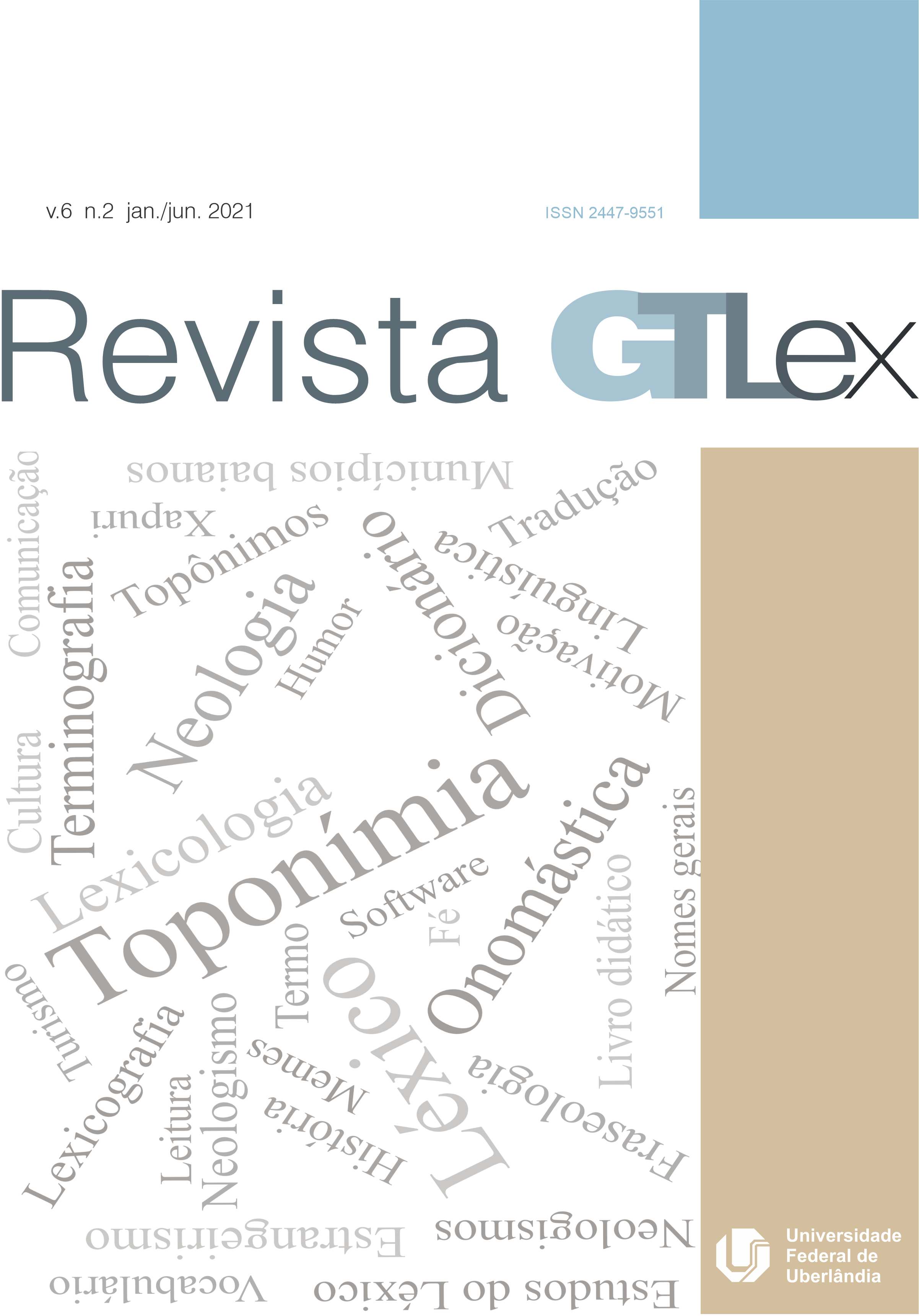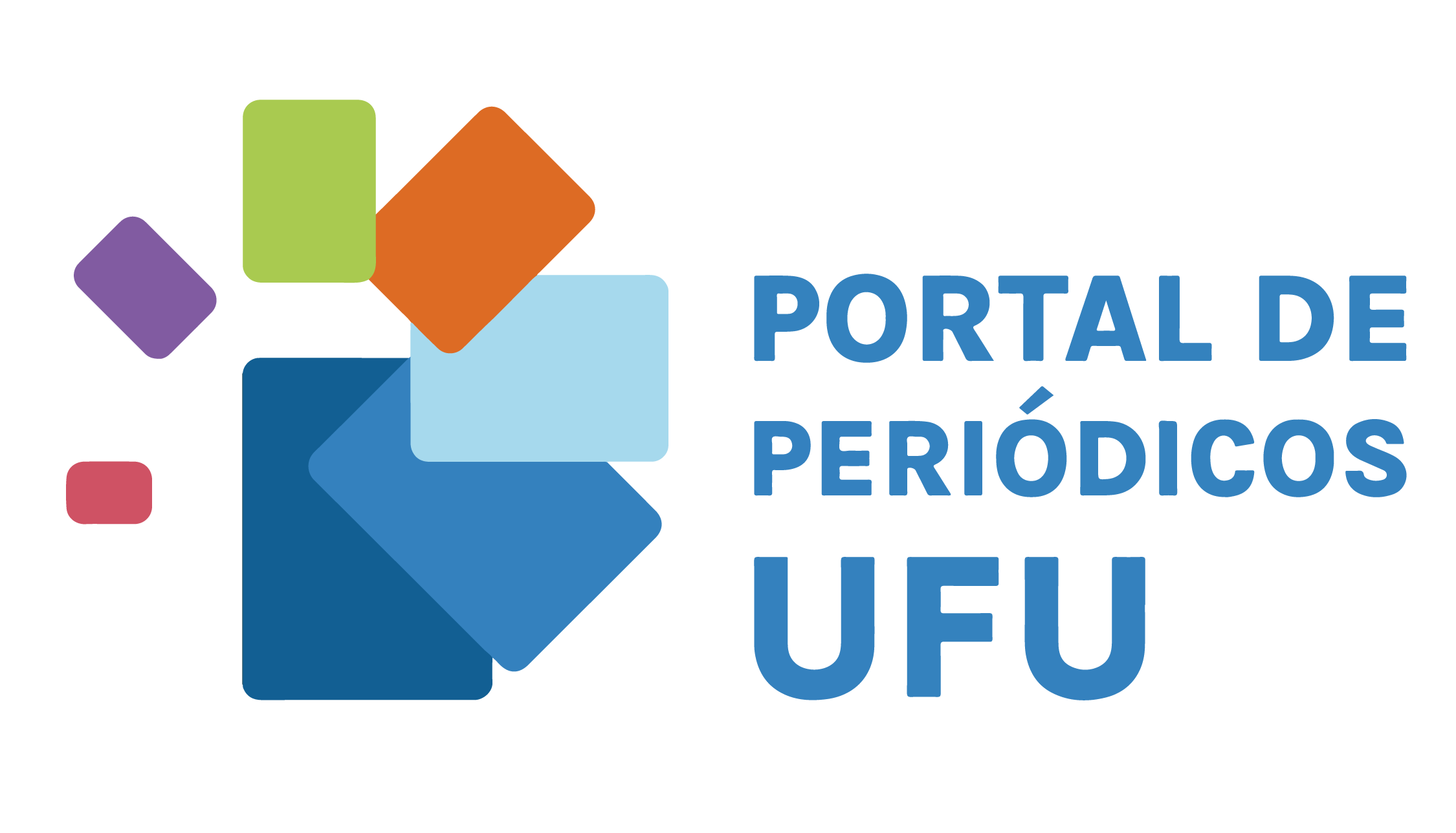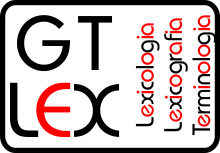The linguistic variation in Portuguese spoken in the paraense northeast countryside
DOI:
https://doi.org/10.14393/Lex12-v6n2a2021-7Keywords:
Sociolinguistics, Geolinguistics, Dialectology, PluridimensionalAbstract
This article presents the report of the development of the research “Semantic and Lexical Aspects of the Portuguese spoken in Pará”, undertaken with the objective of mapping the semantic and lexical aspects of the variety of Portuguese spoken in survey points constituted by the rural areas of the municipalities Inhangapi, Irituia, Marapanim, São Domingos do Capim e São Miguel do Guamá, members of the Amazon region of Pará. The study was guided by the theoretical framework of multidimensional and relational dialectology developed by Thun (1998b) and also by the theoretical-methodological assumptions of Sociolinguistics and Geolinguistics, with reference to authors such as Cardoso and Ferreira (1994), Aguilera (2005), Brandão (2005) and Labov (2008), among others. At each point of inquiry, considering the variables of sex, age and education, ten informants were chosen, which represented the sample population, being applied the semantic-lexical questionnaire (QSL) of the Linguistic Atlas Project of Brazil (ALiB). The analyzes were performed considering the dimensions: diatopic, diageneric and diagenerational variation in the informants' speech. The results were presented in glossaries and linguistic letters to demonstrate the importance of dialectological research for the knowledge of the lexical norm of a geographic space.
Downloads
References
AGUILERA, V. A. Arcaização, mudança e resistência lexicais em atlas linguísticos brasileiros: o rural e o urbano. In: DÖLL, C. et al. (org.). De arte grammatica: Festschrift für Eberhard Gärtnerzuseinem 65. Geburtstag. Frankfurt am Main: Valentia, 2010. p. 19-32.
AGUILERA, V. A. Estudos dialetológicos no Paraná: caminhos e perspectivas. In: GÄRTNER, E.; HUNDT, C.; SCHÖNBERGER, A. (org.). Estudos de geolingüística do português americano. Frankfurt am Main: Valentia, 2009.
AGUILERA, V. A. Crenças e atitudes lingüísticas: quem fala a língua brasileira? In: RONCARATI, C.; ABRAÇADO, J. (org.). Português brasileiro II: contato linguístico, heterogeneidade e história. Niterói: Ed. da UFF, 2008. p. 311-333. Alfa, São Paulo, 56 (3): 871-889, 2012.
ALTENHOFEN, C. V. A Constituição do corpus para um “Atlas Linguístico-Contatual” das Minorias Alemãs na Bacia do Prata. In: Martius – Standen-Jahrbuch, São Paulo, n. 51, p. 135-165, 2004.
ARAGÃO, M. S. S. Atlas Linguístico do Brasil - Estado da Paraíba - ALiB-PB. Conceitos, João Pessoa, v. 5, p.4 2-48, 2004.
BRANDÃO, S. F. A geografia linguística no Brasil. São Paulo: Ática, 2009.
BAGNO, M. Preconceito linguístico: o que é, como se faz. 29ª ed. São Paulo. Loyola, 2015.
BAKHTIN, M. Marxismo e filosofia da linguagem. 5ed. São Paulo: Hucitec, 1990.
BELINE, Ronald. A variação linguística. In: FIORIN, J. L. Introdução à Linguística I. Objetos teóricos. São Paulo. Contexto, 2011. p. 121-140.
CABRAL, A. S. A. C.; RODRIGUES, A. D.; MIDLIN, B.; BRAGA, A. Línguas entrelaçadas, uma situação sui generis de línguas em contato. Papia, v. 21, n. 2, p. 221-230, 2011.
CÂMARA Jr., J. M. Língua e cultura. In: Uchôa, C. E. F. (sel. e introdução.) Dispersos de J. Mattoso Câmara Jr. Rio de Janeiro: Fundação Getúlio Vargas, 1972.
CARDOSO, S. A. M. da S. Geolinguística: tradição e modernidade. São Paulo: Parábola Editorial, 2010.
CARDOSO, M. P. S. da S. Um estudo semântico-lexical com vistas ao Atlas Linguístico da Mesorregião do Marajó/PA. Doutorado em Filologia e Língua Portuguesa. Univrsidade de São Paulo, USP, 2002. (Tese de Doutorado).
CARDOSO, M. P. S. da S. Oralidade e escrita: uma análise prosódica da leitura oral na escola. Universidade Federal do Pará, Belém, 1997 (Dissertação de Mestrado).
¬¬¬¬¬¬¬¬CHOMSKY, N. Aspects of the Theory of Syntax. Cambridge, Massachusetts: the MIT Press, 1965. DOI https://doi.org/10.21236/AD0616323
¬¬¬¬¬¬¬¬CHOMSKY, N. Conhecimento da História e construção teórica na Linguística Moderna. DELTA: Documentação de Estudos em Linguística Teórica e Aplicada, v. 13. SPE, p. 133-155, 1977. DOI https://doi.org/10.1590/S0102-44501997000300005
COELHO, I. L. et al. Para conhecer sociolinguística. São Paulo: Contexto, 2015.
COSERIU, E. Sentido y Tareas de laDialectología. México: Universidad Nacional Autónoma de México / Instituto de Investigaciones Filológicas, 1982.
COMITÊ NACIONAL DO PROJETO ALiB. Atlas Linguístico do Brasil: Questionários. Londrina: Ed. UEL, 2001.
CRUZ, E. História do Pará. Belém: UFPA, v. 2., 1963. (Coleção Amazônica. José Veríssimo). Disponível em: http://livroaberto.ufpa.br/jspui/handle/prefix/99.
D’ANGELIS, W. R. Revitalização de línguas indígenas: como fazemos. Curte Nimuendajú. São Paulo, 2019.
DIETRICH, W.; THUN, H.; SYMEONIDIS, H.; AQUINO, A. Atlas Lingüístico Guaraní – Románico. Tomo 1: Léxico delcuerpo humano (Dialectología pluridimensionalis Románica). Revista Internacional de Lingüística Ibero-americana, Vol. 8, Miscelánea de linguística Ibero-americana, p. 239-242, 2010.
DUBOIS, J. et alii. Dicionário de lingüística. São Paulo: Cultrix, 1978.
FARACO, C. A. Linguística Histórica: uma introdução ao estudo da história das línguas. São Paulo: Parábola Editorial, 2005.
FARACO, C. A. Norma culta brasileira: desatando alguns nós. São Paulo, SP: Parábola, 2008.
FERREIRA, Aurélio. Novo Aurélio Século XXI: o dicionário da língua portuguesa. 3 ed. Rio de Janeiro, 2009.
FERREIRA, C.; CARDOSO, S. A dialectologia no Brasil. São Paulo: Contexto, 1994.
FIORIN, L. J. Linguagem e ideologia. Ática. São Paulo, 2005.
FREIRE, P. Educação como Prática de Liberdade. São Paulo: Ed. Paz e Terra, 2005
GUEDES, R. Estudo Geossociolinguístico da variação lexical na zona rural do Estado do Pará. 2012. Dissertação (Mestrado em Letras) – Instituto de Letras e Comunicação, Universidade Federal do Pará, Belém, 2012.
HODSON, T. C. Sociolinguistics in India. Man in India, v. 19, p. 94-98, 1939.
ISQUERDO, A. N. Os atlas regionais brasileiros publicados e em curso: percursos metodológicos. In: MOTA, J. A.; CARDOSO, S. A. M. (org.). Documentos 2: projeto atlas lingüístico do Brasil. Salvador: Quarteto, 2006. p. 67-94.
JAKOBSON, R. Relações entre a ciência da linguagem e as outras ciências. Lisboa: Bertrand, 1973.
LABOV, W. Sociolinguistic Patterns. Philadelphia: University of Pennsylvania Press, 1972.
LABOV, W. Where does the Linguistic variable stop? A response to Beatriz Lavandera. Sociolinguistic Working Papers, p. 43-88, 1978.
LABOV, W. Building on Empirical Foundations. In: LEHMANN, W.; MALKIEL, Y. Perspectives on Historical Linguistics. Amsterdam: John Benjamins, 1982, 17-92.
LABOV, W. Padrões sociolinguísticos. Tradução de Marcos Bagno, Maria Marta Pereira Scherre, Caroline Rodrigues Cardoso. São Paulo: Parábola Editorial, 2008.
MATTOSO, J. C. Jr. Estrutura de Língua Portuguesa. Ed. Vozes, Petrópolis, 2009.
MELLO, H.; ALTENHOFEN, C.; RASO, T. Os contatos linguísticos no Brasil. Belo Horizonte: Editora UFMG, 2011.
MOLLICA, C. Fundamentação teórica: conceituação e delimitação. In: MOLLICA, C.; BRAGA, M. L. (org.). Introdução à Sociolinguística: o tratamento da variação. São Paulo: Contexto, 2004. p. 9-14.
MONTEIRO, J. L. Para compreender Labov. 2. ed. Petrópolis: Vozes, 2000.
MOTA, J.; CARDOSO, S. Sobre a Dialetologia no Brasil. In: MOTA, J. A.; CARDOSO, S. A. M. Documentos 2: Projeto Atlas Linguístico do Brasil. Salvador: Quarteto, 2006. p. 15-34.
MUSSALIM, F.; BENTES, A. C. Introdução à linguística–domínios e fronteiras. Editora Cortez, 2009.
PAULSTON, C. B.; TUCKER, G. R. Historyofsociolinguistics: introduction. In: Sociolinguistics: the essential readings. Malden: Blackwell Publishing, 2003.
PEREIRA, A. Estudo morfossintático do Asuriní do Xingu. 2009, Tese (doutorado em linguística), Unicamp, Campinas, 2009.
RADTKE, E.; THUN, H. Nuevos caminhos de lageolinguística românica. Um balance. In: RADTKE, E.; THUN, H. Neue Wege der Romanischen Geolinguistik. Kiel: Westensee-Verlag, 1996. p. 25-49.
RODRIGUES, A. D. Os estudos de linguística indígena no Brasil. Revista de Antropologia. São Paulo, 12:09-21, 1963.
RODRIGUES, A. D. Relações internas na família linguística Tupi-Guarani. Revista de Antropologia. São Paulo, n. 27/28, p. 33-53, 1985.
RODRIGUES, A. D. ; CABRAL, A. S. A. C. Revendo a classificação interna da família Tupi-Guarani. In: Atas do I Encontro Internacional do GTLI da ANPOLL. Belém: EDUFPA, 2002.
SILVA, G. F. da. Construindo um dicionário Parakanã-Português. Dissertação (mestrado em linguística), UFPA, Belém, 2003.
SOLANO, E. de J.B. Descrição gramatical da língua araweté. 2009, Tese (doutorado em linguística), UnB, Brasília, 2009.
TARALLO, F. Tempos Linguísticos – itinerário histórico da língua portuguêsa. Ed. Ática, 1990.
THUN, H. La géographie linguistique romane à La fin Du Siècle. Congrès international de linguístique et philologie roamanes, 22., 1998a, Bruxelas. Actes. v.3. Vivacité et diversité de lavariación linguistique. Tübingen: Niemeyer, 1998a. p. 367-388. DOI https://doi.org/10.1515/9783110933109.367
THUN, H. La geolinguística como linguística variacional general (conejemplos del Atlas linguístico Diatópico y Diastrático do Uruguay). Congresso Internazionale di linguistica e filologia romanza, 21, 1995, Palermo. In: RUFINO, G. (org.). Atti. Tübingen: Niemeyer, 1998b. p. 701-729. DOI https://doi.org/10.1515/9783110934038.701
THUN, H. Movilidad demográfica y dimensión topodinámica: Los montevideanos em Rivera, In: RADTKE, E.; THUN, H. (org.). Neuewege der Romanischen Geolinguistik: Akten des Symposiums zur Empirischen Dialektologie. Kiel: Westensee, 1996. p. 210-269.
THUN, H. O português americano fora do Brasil. In: GÄRTNER, E.; HUNDT, C.; SCHÖNBERGER, A. (ed.). Estudos de geolinguística do português americano. Frankfurt a M.: TFM, 2000a. p. 183-213.
THUN, H. Introduction à la tablerond. Congrès international de linguístique et philologie roamanes, 22, 2000b, Bruxelas. Actes. v. 3. Vivacité et diversité de lavariación linguistique. Tübingen: Niemeyer, 2000b. p. 407-409. DOI https://doi.org/10.1515/9783110933109.407
THUN, H. A dialetologia pluridimensional no Rio da Prata. In: ZILLES, A. M. S. (org.). Estudos de variação linguística no Brasil e no Cone Sul. Porto Alegre: Ed. da UFRGS, 2005. p. 63-92.
Downloads
Published
How to Cite
Issue
Section
License
Copyright (c) 2021 Elisa Maria Pinheiro de Souza

This work is licensed under a Creative Commons Attribution-NonCommercial-NoDerivatives 4.0 International License.
Autores que publicam nesta revista concordam com os seguintes termos:
CC BY-NC-ND 4.0: Autores mantém os direitos autorais e concedem à revista o direito de primeira publicação, com o trabalho simultaneamente licenciado sob a Creative Commons Attribution License que permitindo o compartilhamento do trabalho com reconhecimento da autoria do trabalho e publicação inicial nesta revista.
Autores têm autorização para assumir contratos adicionais separadamente, para distribuição não-exclusiva da versão do trabalho publicada nesta revista (ex.: publicar em repositório institucional ou como capítulo de livro), com reconhecimento de autoria e publicação inicial nesta revista.









